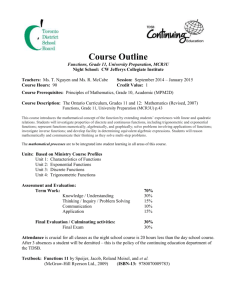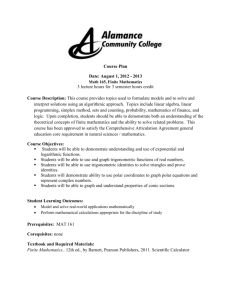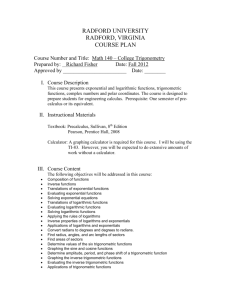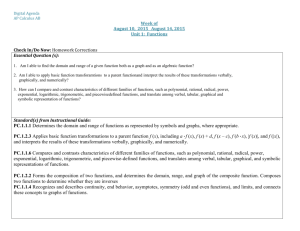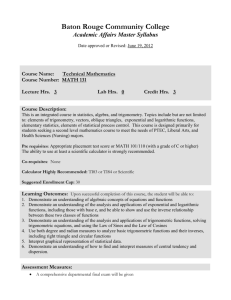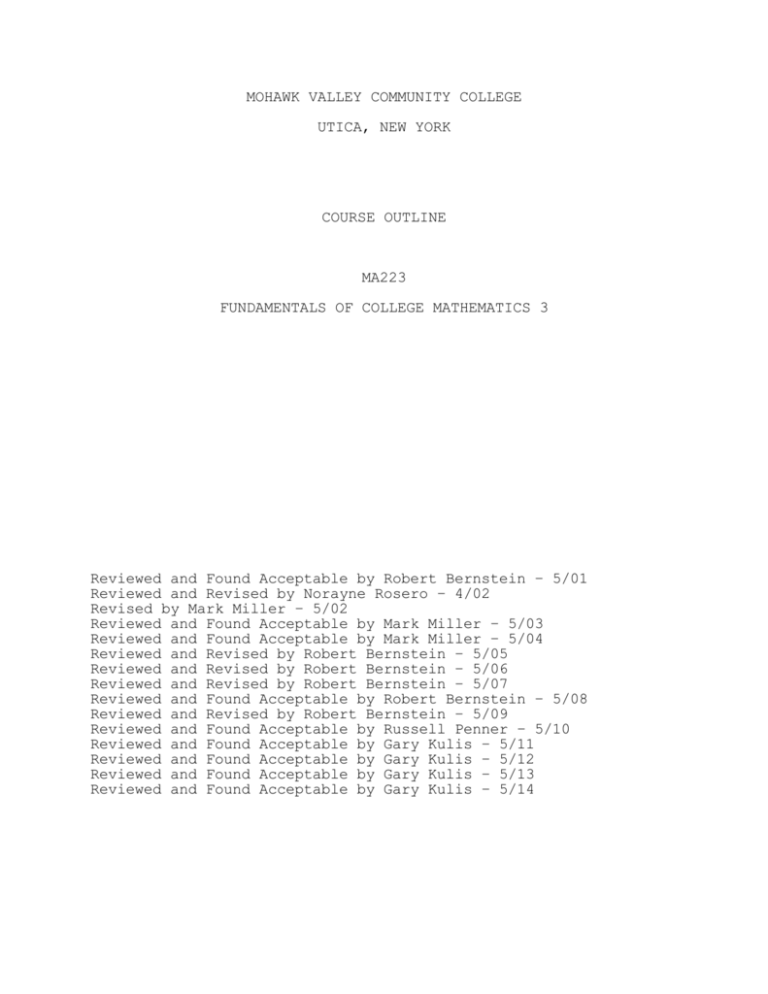
MOHAWK VALLEY COMMUNITY COLLEGE
UTICA, NEW YORK
COURSE OUTLINE
MA223
FUNDAMENTALS OF COLLEGE MATHEMATICS 3
Reviewed and Found Acceptable by Robert Bernstein – 5/01
Reviewed and Revised by Norayne Rosero – 4/02
Revised by Mark Miller – 5/02
Reviewed and Found Acceptable by Mark Miller – 5/03
Reviewed and Found Acceptable by Mark Miller – 5/04
Reviewed and Revised by Robert Bernstein – 5/05
Reviewed and Revised by Robert Bernstein – 5/06
Reviewed and Revised by Robert Bernstein – 5/07
Reviewed and Found Acceptable by Robert Bernstein – 5/08
Reviewed and Revised by Robert Bernstein – 5/09
Reviewed and Found Acceptable by Russell Penner – 5/10
Reviewed and Found Acceptable by Gary Kulis – 5/11
Reviewed and Found Acceptable by Gary Kulis – 5/12
Reviewed and Found Acceptable by Gary Kulis – 5/13
Reviewed and Found Acceptable by Gary Kulis – 5/14
Course Outline
Title:
Fundamentals of College Mathematics 3
Catalog No:
MA223
Credit Hours:
4
Lab Hours:
0
Prerequisites:
MA122 Fundamentals of College Mathematics 2
Catalog
Description:
This course is designed for the
Electrical Engineering Technology
program. Topics include trigonometric
identities and equations, derivatives
and integrals involving trigonometric,
exponential, and logarithmic functions,
and MacLaurin and Fourier Series.
Applications include area, volume,
center of gravity, and periodic
functions.
SUNY Learning Outcomes
1. The student will develop well reasoned arguments by
demonstrating an ability to write proofs.
2. The student will identify, analyze, and evaluate arguments
as they occur in their own and other’s work.
3. The student will demonstrate the ability to interpret and
draw inferences from mathematical models such as formulas,
graphs, tables, and schematics.
4. The student will demonstrate the ability to represent
mathematical information symbolically, visually,
numerically, and verbally.
5. The student will demonstrate the ability to employ
quantitative methods such as arithmetic, algebra, geometry,
or statistics to solve problems.
6. The student will demonstrate the ability to estimate and
check mathematical results for reasonableness.
Major Topics to be Covered:
TOPIC 1:
APPLICATIONS OF INTEGRATION
Using integration to find velocities, displacements, the voltage
across a capacitor, the area under a curve or between two curves,
volumes using disks or using cylindrical shells, and centriods of
plane regions or of solids of revolution are all covered.
Student Learning Outcomes:
Upon successful completion of the course a student will:
1.1
1.2
1.3
1.4
1.5
Find the area under a curve of a function
Determine the area between two curves
Calculate the volumes of solids of revolution
Determine centroids of plan regions
Determine centroids of solids of revolution
TOPIC 2:
ADDITIONAL TOPICS IN TRIGONOMETRY
More advanced topics in trigonometry are introduced, including
verifying trigonometric identities, using sum and difference
formulas and double-angle and half-angle formulas, solving various
types of trigonometric equations, and the inverse trigonometric
functions.
There should be an emphasis on integrating these
topics for application in computational work and problem solving.
Student Learning Outcomes:
Upon successful completion of the course a student will:
2.1
2.2
2.3
2.4
2.5
2.6
Verify trigonometric identities
Solve various types of trigonometric equations
Apply sum and difference formulas, double-angle formulas, and
half-angle formulas
Use basic trigonometric identities to derive other identities
Solve applied problems involving trigonometric equations and
identities
Use inverse trigonometric functions in various types of
problems
TOPIC 3:
DIFFERENTIATION OF TRANSCENDENTAL FUNCTIONS
The derivatives of trigonometric, logarithmic, and exponential functions
are covered. Applications include tangent lines, normal lines, curve
sketching, differentials, maximum and minimum problems, and rates of
change.
Student Learning Outcomes:
Upon successful completion of the course a student will:
3.1
3.2
3.3
3.4
Determine derivatives of functions involving trigonometric
functions
Find the derivatives of functions involving logarithmic
functions
Find the derivatives of functions involving exponential
functions
Provide complete solutions to derivative applications involving
trigonometric, logarithmic, and exponential functions
TOPIC 4:
METHODS OF INTEGRATION
Some integration techniques are covered, including using a substitution
to get it into a “basic form”, and integration by parts. Integration
tables are also used for more complicated integrals.
Student Learning Outcomes:
Upon successful completion of the course a student will:
4.1
4.2
4.3
4.4
4.5
4.6
4.7
Find antiderivatives using the method of u-substitution
Integrate trigonometric, exponential, and logarithmic
functions
Integrate functions that, after a substitution, result in
a natural logarithmic function
Apply the general power formula of integration to various
transcendental functions
Use integration by parts
Use integration to provide complete solutions to applied
problems involving logarithmic and exponential functions
Use integration tables to integrate functions of various
forms
TOPIC 5:
SERIES REPRESENTATION OF FUNCTIONS
Sequences are briefly discussed to help prepare the students for
the study of infinite series. Infinite series are introduced and
some power series, including the MacLaurin Series, are studied.
Convergence and divergence are defined and geometric series are
studied. Operations with series and computations (approximations
of function values) are covered.
An introduction to Fourier
Series is presented along with some applications in electronics
and other fields.
Student Learning Outcomes:
Upon successful completion of the course a student will:
5.1
5.2
5.3
5.4
5.5
5.6
5.7
Write out terms of sequences and series
Determine whether a sequence converges or diverges
Determine whether a series converges or diverges
Develop MacLaurin Series for various functions
Determine a series representation of ex, sinx, cosx,
ln(1 + x), (1 + x)n, and certain related functions
Determine the nth term and nth partial sum of an infinite
series
Provide Fourier Series analysis of certain periodic functions
TEACHING GUIDE
Title:
Fundamentals of College Mathematics 3
Catalog Number:
MA223
Credit Hours:
4
Lab Hours:
0
Prerequisites:
MA122 Fundamentals of College Mathematics 2
Catalog Description:
This course is designed for the
Electrical Engineering Technology
program. Topics include trigonometric
identities and equations, derivatives
and integrals involving trigonometric,
exponential, and logarithmic functions,
and MacLaurin and Fourier Series.
Applications include area, volume,
center of gravity, and periodic
functions.
Text:
Basic
Technical
Mathematics
with
Calculus,
9th
edition,
Allyn
J.
Washington, 2009, Pearson/Prentice Hall
The following laboratory activities, along with others, are
certainly
appropriate
for
occasional
use
in
the
course.
Appropriate supporting tools include the spreadsheet, computer
algebra system, graphics software or the graphics calculator.
1.
The exploration of the graphs of, and developing tables of
data for, function relationships such as those that exist
between a function, its derivatives and its antiderivatives,
or displacement-velocity-acceleration applications.
2.
Solving equations not having a closed form solution with the
use of tables of data.
3.
Investigating optimization problems, related rate problems,
or limits through the use of tables of data, in addition to
using analytical methods.
4.
Curve sketching, or verification of sketches.
5.
Investigating Fourier Series expansions, or Taylor Series
expansions.
Chapter 26 - Applications of Integration
Section
26.1
26.2
26.3
26.4
26.5
26.6
9 hours
Applications of the Indefinite Integral
Areas by Integration
Volumes by Integration
Centroids
Omit
Omit
Chapter 20 - Additional Topics in Trigonometry
Section
20.1
20.2
8 hours
Fundamental Trigonometric Identities
The Sum and Difference Formulas
Note:
The Sum and Difference Formulas for The Tangent are
optional topics.
20.3
20.4
20.5
20.6
Double-Angle Formulas
Half-Angle Formulas
Solving Trigonometric Equations
The Inverse Trigonometric Functions
Supplementary Material - Trigonometric, Exponential, Logarithmic
Equations and Inequalities
3 hours
Chapter 27 - Differentiation of Transcendental Functions 12 hours
Section
27.1
27.2
27.3
27.4
27.5
27.6
27.7
27.8
Derivatives of the Sine and Cosine Functions
Derivatives of the Other Trigonometric Functions
Omit
Applications
Derivative of the Logarithmic Function
Derivative of the Exponential Function
Omit
Applications
Chapter 28 - Methods of Integration
Section
28.1
28.2
28.3
28.4
28.5
28.6
28.7
28.8
28.9
28.10
28.11
The General Power Formula
The Basic Logarithmic Form
The Exponential Form
Basic Trigonometric Forms
Other Trigonometric Forms
Omit
Integration by Parts
Omit
Omit
Omit
Integration by Use of Tables
10 hours
Note:
Stress should be placed on the use of Formulas 29-43
(Trigonometric Forms) from the table in Appendix E.
Supplementary Material - Piecewise Defined
Periodic Functions
Chapter 30 - Expansion of Functions in Series
Section
30.1
30.2
1 hour
11 hours
Infinite Series
MacLaurin Series
Note:
At this time the instructor should look
at the material in 19.1, 19.2, and 19.3.
Also, students may use the computer to
investigate convergence and divergence
of sequences and series.
30.3
Operations with Series
Note:
This section contains justification for
defining the exponential form of a
complex number (equation (12.11) on page
344).
30.4
30.5
30.6
Computation by Use of Series Expansions
Omit
Introduction to Fourier Series
Note:
The integration table in Appendix E
(pages A25 – A27) may be used, as
needed.
If additional exercises are
desired, use some of the functions from
the supplementary material or choose
some of the exercises from section 30.7.
30.7
More About Fourier Series (Optional)
The teaching guide allows 4 additional hours for the in-class
assessment of student learning.
A two hour comprehensive final
examination will also be given.



